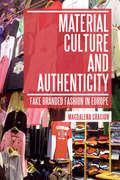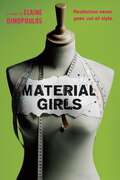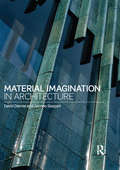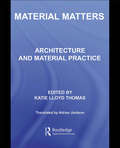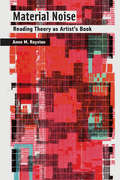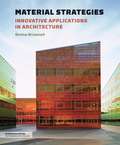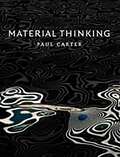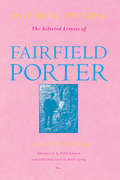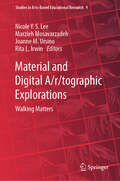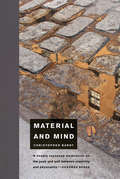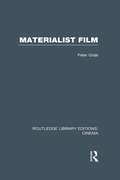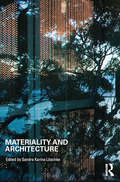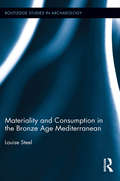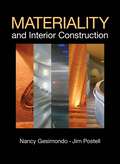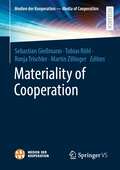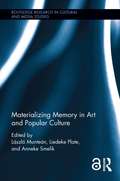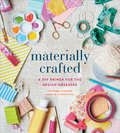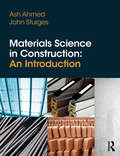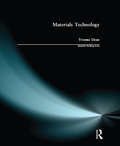- Table View
- List View
Material Culture and Authenticity: Fake Branded Fashion in Europe (Materializing Culture)
by Magdalena CraciunThe study of material culture demonstrates that objects make people just as much as people make, exchange and consume objects. But what if these objects are, in the eyes of others, only fakes? What kind of material mirror are people looking into? Are their real selves really reflected in this mirror? This book provides an original and revealing study into engagements with objects that are not what they are claimed and presumed to be and, subsequently, are believed to betray their makers as well as users. Drawing upon an ethnography of fake branded garments in Turkey and Romania, Material Culture and Authenticity shows how people can make authentic positions for themselves in and through fake objects.The book will be of interest to students and scholars working in the fields of anthropology, material culture and cultural studies as well as to general readers interested in ethnographic alternatives to biographies of famous fakers and fakes.
Material Girls: A Novel
by Elaine DimopoulosIn Marla Klein and Ivy Wilde&’s world, teens are the gatekeepers of culture. A top fashion label employs sixteen-year-old Marla to dictate hot new clothing trends, while Ivy, a teen pop star, popularizes the garments that Marla approves. Both girls are pawns in a calculated but seductive system of corporate control, and both begin to question their world&’s aggressive levels of consumption. Will their new &“eco-chic&” trend subversively resist and overturn the industry that controls every part of their lives? Smart, provocative, and entertaining, this thrilling page-turner for teens questions the cult like mentality of fame and fashion. Are you in or are you out?
Material Imagination in Architecture
by David Dernie Jacopo GaspariMaterial Imagination in Architecture draws on history and the visual arts, and contemporary architecture to explore this popular theme in architectural practice and education. In the context of a discipline increasingly driven by digital production, this text explores architecture and making and the diverse influences on the material reality of architectural form: it argues that the crafts, fabrication and assemblage of its making remain vital elements of contemporary architectural language. This broad-ranging text bridges the gap between a technical or otherwise fragmentary knowledge of materials of the specialist, and the tacit or instinctive understanding of materials that the artist, sculptor or architect may have. It identifies key material themes pertinent to contemporary architectural debate and develops a discourse about future practice that is framed by environmental imperatives and grounded in a historical understanding of the meaning and use of materials. Material iconology in architecture is a well-established tradition and this book draws on that background to investigate the possibilities, and limits, of using materials in contemporary design to communicate the themes and contexts of an architectural project, a material’s relationship to context, and to the history of practices that belong to the traditions of making buildings. Each theme is explored in case studies from twelve countries around the world, including the UK, USA, Spain, Italy, Germany, Australia and China.
Material Matters: Architecture and Material Practice
by Katie Lloyd ThomasBringing together texts and work by theorists and practitioners who are making material central to their work, this book reflects the diverse areas of inquiry which are expanding current material discourse. Focusing on the cultural, political, economic, technological and intellectual forces which shape material practices in architecture, the contributors draw on disciplines ranging from philosophy, history and pedagogy to art practice and digital and low-tech fabrication. By paying critical attention to material, a wide range of issues emerge which are otherwise excluded from architectural discourse, issues that shape and determine the buildings we make, the processes we use and the ways we understand them. Beautifully illustrated and designed, this book is a unique collection which will be of great interest to architectural practitioners and theorists who want to consider the wider implications of material practice, and to students who are developing their own approach to making buildings.
Material Noise: Reading Theory as Artist's Book
by Anne M. RoystonAn argument that theoretical works can signify through their materiality—their “noise,” or such nonsemantic elements as typography—as well as their semantic content. In Material Noise, Anne Royston argues that theoretical works signify through their materiality—such nonsemantic elements as typography or color—as well as their semantic content. Examining works by Jacques Derrida, Avital Ronell, Georges Bataille, and other well-known theorists, Royston considers their materiality and design—which she terms “noise”—as integral to their meaning. In other words, she reads these theoretical works as complex assemblages, just as she would read an artist's book in all its idiosyncratic tangibility. Royston explores the formlessness and heterogeneity of the Encyclopedia Da Costa, which published works by Bataille, André Breton, and others; the use of layout and white space in Derrida's Glas; the typographic illegibility—“static and interference”—in Ronell's The Telephone Book; and the enticing surfaces of Mark C. Taylor's Hiding, its digital counterpart The Réal: Las Vegas, NV, and Shelley Jackson's Skin. Royston then extends her analysis to other genres, examining two recent artists' books that express explicit theoretical concerns: Johanna Drucker's Stochastic Poetics and Susan Howe's Tom Tit Tot.Throughout, Royston develops the concept of artistic arguments, which employ signification that exceeds the semantics of a printed text and are not reducible to a series of linear logical propositions. Artistic arguments foreground their materiality and reflect on the media that create them. Moreover, Royston argues, each artistic argument anticipates some aspect of digital thinking, speaking directly to such contemporary concerns as hypertext, communication theory, networks, and digital distribution.
Material Strategies
by Blaine BrownellIn the successful Transmaterial series, author Blaine Brownell presents collections of materials that have the potential to transform the physical environment. With Materials Strategies, Princeton Architectural Press s next book in its Architecture Brief series, Brownell takes his research to the next stage by addressing how materials be applied to affect such a transformation, ultimately achieving design innovation. [Architecture has been shaped by the continual transformation of material technologies and application methods throughout history. Surprisingly, these approaches are rarely taught in academia or practice the former typically focuses on building-technology sequence, where students are given information about basic material properties and conventional methodologies. Architectural practice is worse: in the majority of offices, there is no established discipline or method for material innovation despite the widespread belief in its importance. ] [katharine, this whole paragraph could be cut if this is too much, which I think it is. ] Material Strategies is a primer on materials that goes beyond a mere description of materials. It provides insights regarding emerging technologies as well as their creative implementation, and presents a series of recent case studies that demonstrate successful realization of material-based innovation. The book is structured by a concise set of chapters based on fundamental material categories mineral, concrete, wood, metal, glass, and plastic. The introduction of each chapter describes the basic history of the material and its importance to architecture, a summary of previous building innovations and their technological as well as cultural effects, current environmental challenges and their future ramifications, recent disruptive technologies and their preliminary manifestations, as well as a series of disruptive applications exemplified by recent pioneering buildings. Architectural case studies are described with a focus on the significance of their particular contributions, and are documented in detailed illustrations. The primary attention of the book is on contemporary projects because of the ways in which these buildings deliver creative contributions related to present-day circumstances. Unlike many how-to manuals, the emphasis here is on unconventional and emerging practices. Moreover, unlike many surveys of new materials, this manual seeks to explain which new material technologies are most significant and why, how these technologies are being influenced by recent environmental concerns, the theoretical implications and conceptual debates one must consider, as well as the ways in which new material strategies are utilized to advance the architectural canon.
Material Strategies in Digital Fabrication
by Christopher BeorkremIn this second edition of Material Strategies in Digital Fabrication are new case studies, improved wayfinding, the inclusion of composites and plastics, and references to similar strategies between different projects. In 400 step-by-step diagrams dissecting 39 case studies in 10 countries on 3 continents, the book shows you how material performance drives the digital fabrication process and determines technique. The book identifies the important characteristics of each material, including connection types, relative costs, deformation, color, texture, finish, dimensional properties, durability, and weathering and waterproofing to link design outcomes to form. The book is divided into five main chapters by material; wood, metal, concrete/masonry, composites/plastics, and recycled/pre-cycled, to help you reference construction techniques for the fabrication machines you have on-hand. Includes projects by SHoP Architects, Gramazio & Kohler, Schindlersalmeron, The Institute for Computational Design (Achim Menges, Patkau Architects,Sebastien Wierinck, Blue Dot Furniture, Marble Fairbanks, Studio Gang Architects, Macdowell.Tomova, Thomas Heatherwick Studio, Heather Roberge, MX3D, Matsys, Asbjorn Sondergaard, Block Research Group (Phillipe Block), Ball Nogues Studio, Matter Design, WORK Architecture Company, and SoftLab.
Material Theories: Locating Artefacts and People in Gottfried Semper's Writings (Routledge Research in Interior Design)
by Elena ChestnovaMaterial Theories takes a radically new approach to well-established thinking on nineteenth-century architecture and design by investigating Gottfried Semper’s classic ideas about dressing, metamorphosis of material, and cultural development, culminating in his two-volume publication Style. This book demonstrates how Semper’s theories crystallised among his encounters with material things of the late 1840s and early 1850s. It examines several discursive frameworks and phenomena which shaped the attitude to artefacts in Europe in the mid-nineteenth century, and which were specifically pertinent to Semper’s evolution: archaeology and antiquarianism, the domestic interior, print media, collections, and the embodied relationship between the designer and their work. For the first time, this book examines the construction of a design theory not only as an intellectual endeavour but also as a process of confrontation with material things. It employs recent approaches to material culture, in particular Thing Theory, in order to show that Semper’s artefact references constituted his ideas, rather than simply giving impetus to them. It will be an important investigation for academics and researchers interested in interior design history, as well as scholars of material culture and history of design theory.
Material Thinking
by Paul CarterMaterial Thinking is a ground-breaking book for artists, and for those who study or teach in the arts. Author and artist Paul Carter provides an intimate, first-hand account of how ideas are turned into works, and how the material thinking these artworks embody produces new understandings about ourselves, our histories and the culture we inhabit. Taking as his subject several artistic collaborations which resulted in performances, exhibitions or videos, Carter explores how each unfolded. In the course of this analysis he constructs a philosophy of how the practice and theory of making art are interconnected, a philosophy powerful enough to provide an intellectual underpinning for the new, and still developing, field of creative research. ---- 'Here is startling, practical erudition. Prodigious book-learning is laced with real understanding of what it means to make art, to infuse sullen matter with something rousing, delicate and vital.' -Ross Gibson, Research Professor of New Media & Digital Culture, UTS 'For twenty years I have campaigned for, and conducted, research in the medium of architecture itself, research that is not "about" architecture but "of" if. Carter begins by drawing the same distinction, but his ambition is greater: he seeks to explore and define research in the zones where creative mediums shade into each other. To work in a zone is to collaborate with practitioners who are centred on their medium of practice. Carter posits a new role for the critic, not outside looking in, not "about" practice but inside, "of", and pushing practitioners towards the liminal, and thus toward the innovative.' -Leon van Schaik, Innovation Professor of Architecture, RMIT
Material Witness
by Ted LeighAmerican painter Fairfield Porter (1907-1975) was an iconoclast who developed a singular style that was outside the politically correct boundaries of both left and right. This collection of letters sheds light on Porter's personal views and displays his acumen as a political critic. It encompasses letters from his early travels to the Soviet Union (including a description of an interview with Trotsky) as well as later correspondence with close friends. The volume features an introduction by poet/critic David Lehman and notes by Justin Spring, author of . Editor Leigh is an artist, writer, and teacher. Annotation ©2005 Book News, Inc. , Portland, OR (booknews. com)
Material World: The Modern Craft Bible
by Perri LewisTired of the clichés often trotted out about craft, Perri Lewis makes it her task to bring the world of making into the 21st century.In Material World, Perri enlists the help of luminaries from the worlds of art, craft, design and fashion to share their knowledge and advice. Among these include Rob Ryan, Emma Bridgewater, Grayson Perry, Philip Treacy, Tatty Devine, Topshop and Tracey Emin. Instead of just giving the reader individual projects, you can learn the techniques for crafts such as paper-cutting, dress-making, printing, encrusting, leather work and tailoring. However, if you prefer more guidance, there are 15 projects to make, including découpage shoes, a patchwork Louis chair and a printed scarf. With the compiled words of wisdom of these experts, and Perri's own timeless advice, you'll be up and running with scissors in no time.
Material and Digital A/r/tographic Explorations: Walking Matters (Studies in Arts-Based Educational Research #9)
by Rita L. Irwin Nicole Y. S. Lee Joanne M. Ursino Marzieh MosavarzadehThis book considers the generative tension between the materiality and virtuality of walking methodologies in a/r/tography and arts-based educational research. It explores the materiality of practice—manifestations, manipulations, residues, and traces of both real and imagined experiences and events. Authors present artistic representations, renderings, artifacts, and documentations that allow for various forms of return and re-visitation of places/spaces and temporal moments. The book also investigates the digital and virtual, including video, images, media work, and emergent technologies that allow one to literally, metaphorically, affectively, and conceptually go somewhere that might be previously impossible to reach. Authors consider curricular and pedagogical implications of digital/virtual walking in relation to desire, agency, autonomy, freedom, and other issues around ethics.The book brings together entanglements of the corporeal and incorporeal, addressing thequestions: How does the (im)materiality of bodies/characters-in-motion in a/r/tographic practices shape understandings of place, space, and the self-in-relation? How do issues and particularities come to matter through one’s entanglements with(in) the (in)corporeal?
Material and Mind
by Christopher BardtAn in-depth exploration of the interaction between mind and material world, mediated by language, image, and making—in design, the arts, culture, and science. In Material and Mind, Christopher Bardt delves deeply into the interaction of mind and material world, mediated by language, image, and the process of making. He examines thought not as something “pure” and autonomous but as emerging from working with material, and he identifies this as the source of imagination and creative insight. This takes place as much in such disciplines as cognitive science, anthropology, and poetry as it does in the more obvious painting, sculpture, and design. In some fields, the medium of work is, in fact, the very medium of thinking—as fabric is for the tailor. Drawing on the philosophical notions of the “extended mind” and the “enactive mind,” and looking beyond the world of material-based arts, Bardt investigates the realms in which material and mind interweave through metaphor, representation, projection, analogues, tools, and models. He considers words and their material origins and discusses the paradox of representation. He draws on the design process, scientific discovery, and cultural practice, among others things, to understand the dynamics of human thinking, to illuminate some of the ways we work with materials and use tools, and to demonstrate how our world continues to shape us as we shape it. Finally, he considers the seamless “immaterial” flow of imagery, text, and data and considers the place of material engagement in a digital storm.
Material: Making and the Art of Transformation
by Nick KaryA master craftsperson explores the ways in which working with our hands reveals the essence of both our humanity and our relationship with the natural, material world In our present age of computer-assisted design, mass production and machine precision, the traditional skills of the maker or craftsperson are hard to find. Yet the desire for well-made and beautiful objects from the hands (and mind) of a skilled artisan is just as present today as it ever has been. Whether the medium they work with is wood, metal, clay or something else, traditional makers are living links to the rich vein of knowledge and skills that defines our common human heritage. More than this, though, many of us harbor a deep and secret yearning to produce something – to build or shape, to imagine and create our own objects that are imbued not only with beauty and functionality, but with a story and, in essence, a spirit drawn from us. Nick Kary understands this yearning. For nearly four decades he has worked on commission to make fine, distinctive furniture and cabinets from wood, most of it sourced near his home, in the counties of South West England. During this time, he has been both a teacher and a student; one who is fascinated with the philosophy and practice of craft work of all kinds. In Material, Kary takes readers along with him to visit some of the places where modern artisans are preserving, and in some cases passing on, the old craft skills. His vivid descriptions and eye for detail make this book a rich and delightful read, and the natural and cultural history he imparts along the way provides an important context for understanding our own past and the roots of our industrial society. Personal, engaging, and filled with memorable people, landscapes and scenes, Material is a rich celebration of what it means to imagine and create, which in the end is the essence of being human, and native to a place. As Kary puts it, “Wood and words, trees and people, material and ethereal – it is here I love increasingly to dwell.”
Material: Making and the Art of Transformation
by Nick Kary"An important book, brimming with insight."—Nicholas Evans, author of The Horse WhispererA master craftsperson explores the ways in which working with our hands reveals the essence of both our humanity and our relationship with the natural, material world.In our present age of computer-assisted design, mass production and machine precision, the traditional skills of the maker or craftsperson are hard to find. Yet the desire for well-made and beautiful objects from the hands (and mind) of a skilled artisan is just as present today as it ever has been. Whether the medium they work with is wood, metal, clay or something else, traditional makers are living links to the rich vein of knowledge and skills that defines our common human heritage. More than this, though, many of us harbor a deep and secret yearning to produce something – to build or shape, to imagine and create our own objects that are imbued not only with beauty and functionality, but with a story and, in essence, a spirit drawn from us.Nick Kary understands this yearning. For nearly four decades he has worked on commission to make fine, distinctive furniture and cabinets from wood, most of it sourced near his home, in the counties of South West England. During this time, he has been both a teacher and a student; one who is fascinated with the philosophy and practice of craft work of all kinds.In Material, Kary takes readers along with him to visit some of the places where modern artisans are preserving, and in some cases passing on, the old craft skills. His vivid descriptions and eye for detail make this book a rich and delightful read, and the natural and cultural history he imparts along the way provides an important context for understanding our own past and the roots of our industrial society.Personal, engaging, and filled with memorable people, landscapes and scenes, Material is a rich celebration of what it means to imagine and create, which in the end is the essence of being human, and native to a place. As Kary puts it, &“Wood and words, trees and people, material and ethereal – it is here I love increasingly to dwell.&”Perfect for fans of The Hidden Life of Trees or Norwegian Wood, Material is a rich, inspiring read for woodworkers, potters, craftspeople, bibliophiles and anyone who enjoys working with their hands.
Materialist Film (Routledge Library Editions: Cinema)
by Peter GidalA polemical introduction to the avant-garde and experimental in film (including making and viewing), Materialist Film is a highly original, thought-provoking book. Thirty-seven short chapters work through a series of concepts which will enable the reader to deal imaginatively with the contradictory issues produced by experimental film. Each concept is explored in conjunction with specific films by Andy Warhol, Malcolm LeGrice, Lis Rhodes, Jean-Luc Goddard, Rose Lowder, Kurt Kren, and others. Peter Gidal draws on important politico-aesthetic writings, and uses some of his own previously published essays from Undercut, Screen, October, and Millennium Film Journal to undertake this concrete process of working through abstract concepts. Originally published in 1989.
Materiality and Architecture
by Sandra Karina LoschkeOnce regarded a secondary consideration, in recent years, materiality has emerged as a powerful concept in architectural discourse and practice. Prompted in part by developments in digital fabrication and digital science, the impact of materiality on design and practice is being widely reassessed and reimagined. <P><P>Materiality and Architecture extends architectural thinking beyond the confines of current design literatures to explore conceptions of materiality across the field of architecture. Fourteen international contributors use elucidate the problems and possibilities of materiality-based approaches in architecture from interdisciplinary perspectives. The book includes contributions from the professions of architecture, art, architectural history, theory and philosophy, including essays from Gernot Böhme, Jonathan Hill and Philip Ursprung. <P><P>Important 'immaterial' aspects such as presentation, agency, ecology and concept are examined, deepening our understanding of materiality’s role in architectural processes, the production of cultural identities, the pursuit of political agendas, and the staging of everyday environments and atmospheres. In-depth illustrated case studies examine works by Herzog & de Meuron, Zaha Hadid, and Lacaton & Vassal, interspersed with visual essays and interviews with architects such as MVRDV providing a direct connection to practice. Materiality and Architecture is an important read for researchers and students with an interest in architectural theory and related fields such as art, art history, or visual and cultural studies.
Materiality and Consumption in the Bronze Age Mediterranean: Materiality And Consumption In The Bronze Age Mediterranean (Routledge Studies in Archaeology #7)
by Louise SteelThe importance of cultural contacts in the East Mediterranean has long been recognized and is the focus of ongoing international research. Fieldwork in the Aegean, Egypt, Cyprus, and the Levant continues to add to our understanding of the nature of this contact and its social and economic significance, particularly to the cultures of the Aegean. Despite sophisticated discussion of the archaeological evidence, in particular on the part of Aegean and Mediterranean archaeologists, there has been little systematic attempt to incorporate anthropological perspectives on materiality and exchange into archaeological narratives of this material. This book addresses that gap and integrates anthropological discourse on contact, examining exchange systems, the gift, notions of geographical distance and power, colonization, and hybridization. Furthermore, it develops a social narrative of culture contact in the Mediterranean context, illustrating the reasons communities chose to engage in international exchange, and how this impacted the construction of identities throughout the region. While traditional archaeologies in the East Mediterranean have tended to be reductive in their approach to material culture and how it was produced, used, and exchanged, this book reviews current research on material culture, focusing on issues such as the biography of objects, inalienable possessions, and hybridization – exploring how these issues can further illuminate the material world of the communities of the Bronze Age Mediterranean.
Materiality and Interior Construction
by Nancy Gesimondo Jim PostellA comprehensive reference of materials for interior designers and architects Choosing the right material for the right purpose is a critical-and often overlooked-aspect in the larger context of designing buildings and interior spaces. When specified and executed properly, materials support and enhance a project's overall theme, and infuse interior space with a solid foundation that balances visual poetry and functionality. Materiality and Interior Construction imparts essential knowledge on how materials contribute to the construction and fabrication of floors, partitions, ceilings, and millwork, with thorough coverage of the important characteristics and properties of building materials and finishes. Individual coverage of the key characteristics of each material explores the advantages and disadvantages of using specific materials and construction assemblies, while helping readers discover how to make every building element count. In addition, Materiality and Interior Construction: Is highly illustrated throughout to show material properties and building assemblies Supplies rankings and information on the "green" attributes of each material so that designers can make informed decisions for specifications Is organized by application for easy and quick access to information Includes a companion website, featuring an extensive online image bank of materials and assemblies Rather than a typical catalog of materials, Materiality and Interior Construction is efficiently organized so that the reader is guided directly to the options for the location or assembly they are considering. Reliable and easy to use, Materiality and Interior Construction is a one-stop, comprehensive reference for hundreds of commonly used materials and their integration as building components-and an invaluable resource that every interior designer or architect should add to their set of tools.
Materiality of Cooperation (Medien der Kooperation – Media of Cooperation)
by Martin Zillinger Tobias Röhl Sebastian Gießmann Ronja TrischlerThe volume investigates the socio-material dimension and media practices of cooperation – before, during and beyond situations. Cooperation is understood as reciprocal interplay operating with or without consensus, in co-presence or absence of the involved actors in distributed situations. Artefacts, bodies, texts and infrastructures are the media that make cooperation possible. They enable and configure reciprocal accomplishments – and are themselves created through media practices in cooperative situations.
Materialized Identities in Early Modern Culture, 1450-1750: Objects, Affects, Effects (Visual and Material Culture, 1300-1700)
by Ulinka Rublack Susanna Burghartz Lucas Burkart Christine GottlerThis collection embraces the increasing interest in the material world of the Renaissance and the early modern period, which has both fascinated contemporaries and initiated in recent years a distinguished historiography. The scholarship within is distinctive for engaging with the agentive qualities of matter, showing how affective dimensions in history connect with material history, and exploring the religious and cultural identity dimensions of the use of materials and artefacts. It thus aims to refocus our understanding of the meaning of the material world in this period by centring on the vibrancy of matter itself. To achieve this goal, the authors approach the material through four themes, glass, feathers, gold paints, and veils, in relation to specific individuals, material milieus, and interpretative communities. In examining these four types of materialities and object groups, which were attached to different sensory regimes and valorizations, this book charts how each underwent significant changes during this period.
Materializing Memory in Art and Popular Culture (Routledge Research in Cultural and Media Studies)
by Liedeke Plate Anneke Smelik Laszlo MunteanMemory matters. It matters because memory brings the past into the present, and opens it up to the future. But it also matters literally, because memory is mediated materially. Materiality is the stuff of memory. Meaningful objects that we love (or hate) function not only as aide-mémoire but are integral to memory. Drawing on previous scholarship on the interrelation of memory and materiality, this book applies recent theories of new materialism to explore the material dimension of memory in art and popular culture. The book’s underlying premise is twofold: on the one hand, memory is performed, mediated, and stored through the material world that surrounds us; on the other hand, inanimate objects and things also have agency on their own, which affects practices of memory, as well as forgetting. By accounting for the material world as a medium through which acts of remembering and forgetting take place, the chapters of this book offer new insights on such topics as the study of ruins, the exchange and circulation of souvenirs, digitization and the Internet of Things, fashion and technology, as well as the material dimensions of corporeality and traumatic re-enactment.
Materially Crafted: A DIY Primer for the Design-Obsessed
by Victoria Hudgins&“Perfect for anyone embracing their crafty side for the first time (or those who just want to keep developing their design chops)&” (HGTV). Design enthusiasts are bombarded with beautiful inspiration at every turn, but many lack the foundation necessary to recreate their dream projects. In Materially Crafted, Victoria Hudgins, creator of the popular design blog A Subtle Revelry, uncovers the best and least intimidating ways to work with the most popular crafting materials—from spray paint and concrete to thread, wax, and paper—and presents more than thirty easy projects to get everyone started. Peppered with Hudgins&’s tips for &“merrymaking the everyday&” (using simple DIY ideas to live life more joyfully) plus inspirational photos of projects created by other prominent bloggers, Materially Crafted is an indispensable guide for a new generation of design enthusiasts looking to DIY their own distinctive style. &“Her book focuses on materials and great ways (including 30 main projects) to transform them into something special.&” —Design*Sponge
Materials Science In Construction: An Introduction
by Arshad Ahmed John SturgesMaterials Science in Construction explains the science behind the properties and behaviour of construction's most fundamental materials (metals, cement and concrete, polymers, timber, bricks and blocks, glass and plaster). In particular, the critical factors affecting in situ materials are examined, such as deterioration and the behaviour and durability of materials under performance. An accessible, easy-to-follow approach makes this book ideal for all diploma and undergraduate students on construction-related courses taking a module in construction materials.
Materials Technology (Mitchell's Building Series)
by Yvonne DeanMaterials Technology clearly identifies materials and technology as the fundamental generators of buildings and examines how they determine the structure, overall form and quality. It examines the issues that determine the choice of materials, and argues that the decision-making of architects, engineers and designers should take account of the environmental impact of sourcing the basic materials, and of the energy implications of their processing and use in manufacturing.Materials Technology is an essential resource for Materials Technology units in building, architecture and surveying degree and postgraduate courses; and students of BTEC HNC/D building and surveying. It will also be a useful reference tool for Advanced GNVQ Construction and the Built Environment courses and Built Environment NVQs at levels 3 and 4.
